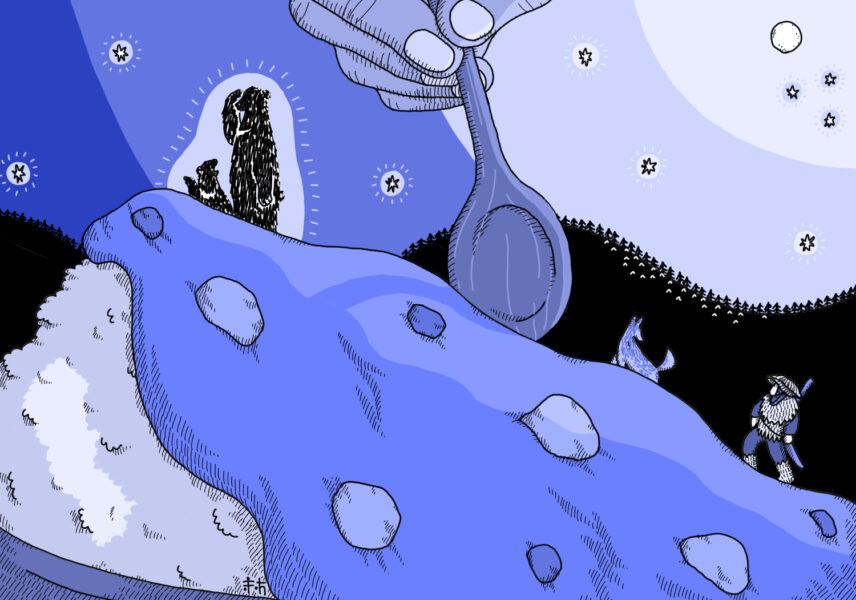Nathan Badenoch (Linguistics)
Living in Japan, your surroundings talk to you—along the Kamo River, in the local Lawson, walking up to Yoshida Shrine, or on the 205 bus—through onomatope, or onomatopoeia. There is an onomatope layer of life in Japanese, where sounds and meanings are matched in a different way than the “normal” words of daily conversation. If your hair is tsuyatsuya, you are happy that is silky yet shiny. I would say that you “feel” these words more than you “understand” them. That is why you will find them used in the names of food and beauty products. English doesn’t have many of these words, but most of the world’s languages do.
In my Japanese literature class in Philadelphia, we read Miyazawa Kenji’s short story “The Bears of Nametoko” in translation. In the original, he describes the main character walking bochabocha up a valley—a wet sound that wants you to feel that it is hard going. But he really wants to tell you is that the bears that he hunts actually like him for this. Miyazawa uses lots of onomatope like this in his writings to bring experiences and environments to life. The Onomatope of Miyazawa Kenji [Kurihara and Sugita 2023, Chikuma Bunko] introduces some of his best. He uses many of these in strange ways, which is why people like them so much. I have a friend in northern Kyoto who also uses onomatope in weird ways. She creates her own sometimes. She says, “It just feels like that.” One day, she described a curry rice dish as duruduru. Many people would use dorodoro for a thick curry. But wait, Japanese doesn’t even have the sound du. Dorodoro can also describe complicated, sticky relations between people. Is that also duruduru, I asked her? Probably not.
People understand what she is saying, but are they really getting the feeling that she wants? To a certain degree, yes, because native speakers share some basic but very strong feelings about their language. Of course, you won’t find her innovations in any of the huge Japanese onomatope dictionaries. A dictionary is a serious thing. It controls the language, even if the writers are trying to describe the language as it is spoken. To Japanese ears, onomatope sound like what they mean. They are fun to hear, fun to say. Ono Masahiro, the author of a 4500-entry Japanese onomatope dictionary, has said that these words are nagomi—something that is soft, soothing, relaxing and freeing. The meanings are very specific, but very often difficult to explain. And hard to control sometimes.
In fact, I have written a dictionary of onomatope for a language called Mundari, which spoken in Eastern India. There are so many onomatope in this language that Osada Toshiki, a linguist, and Madhu Purti, a native speaker of the language, decided that we need a dictionary. Our dictionary—A Dictionary of Mundari Expressives has definitions and examples in both Japanese and English. When Madhu Purti sings songs in Mundari, they are filled with onomatope. When she tells stories, they overflow with onomatope. One time, we got so deep into the discussion of how Mundari onomatope could describe different types of Indian curry—what is the difference between lede-pede, lada-pada and lodo-podo?—that we wrote an academic paper about it. Just like my friend’s “strange” curry description, Mundari speakers feel difference in the type of curry when the vowels are changed.
Another of my best friends is a farmer in the mountains of northern Laos. He speaks a language called Bit. Whenever we spend time together, I learn new onomatope. Sometimes as many as ten or twenty in a day. Seriously. Bit folktales are festivals of onomatope. One of my favorite storytellers sometimes just lines up a string of onomatope to tell part of a story. Onomatope make up about 1/3 of the 7,000-word dictionary we are making. There seems to be no end to the onomatope in Bit and in Mundari. I learn new Japanese onomatope all the time too. When people ask what it is like to speak many languages, I often explain how I have a different sense of humor in each language. But I also believe that the world feels just little different in these languages, because through onomatope, our surroundings speak to us directly. Onomatope are playful. Each language has a different way of linking sounds with meanings, but onomatope help us to have a conversation with the environment we lives in. I think onomatope have taught me the most important lesson about language—how to feel meaning through sound. What is that curry on your plate telling you?
(Illustration: Atelier Epocha)
This article is also available in Japanese. >>
「カレーの声が聞こえる時」
(ネイサン・バデノック)






